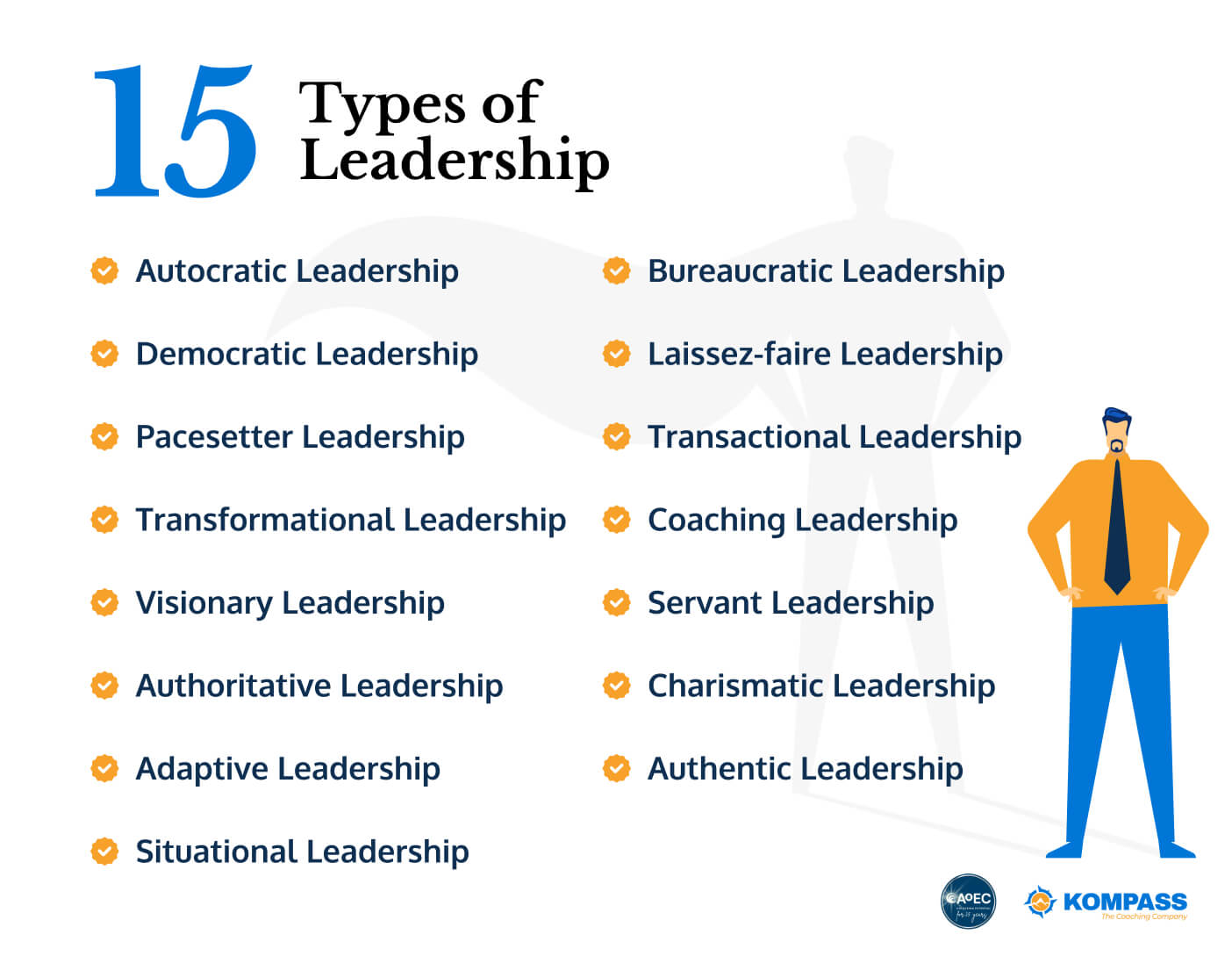Just like people have their own unique personalities, leaders also have different ways of leading others. Whether you’re leading a project, a team, a department, or even a whole organisation, it’s easier to lead well when you understand what kind of leader you are and what kind of leader your role needs you to be.
Your leadership style is the way you guide, manage, and inspire others. It shows in how you communicate with your team, set goals, and make decisions that benefit your team, your company, and everyone involved.
There’s no single “right” way to lead. The best leadership style can change depending on your situation, your workplace culture, and the people you work with. At Kompass Consultancy, we support leaders through executive coaching in Dubai and Abu Dhabi, helping them understand and improve their leadership style.
Every leader is different, but many can be grouped into common types based on how they lead. Below, we’ve shared 15 leadership styles, including the benefits and challenges of each, to help you find the one that matches your values and fits your team.

1. Autocratic Leadership
Autocratic leadership, also referred to as authoritarian, is characterised by a leader whose primary focus is on delivering results and increasing team efficiency. To streamline decision-making, they make tough choices based on their own judgment and expertise. At most, they only involve a select group of people.
Autocratic leaders are accountable for their decisions and expect their teams to follow through with their recommendations. They’re dependable and self-motivated leaders who can communicate clearly and thrive in highly structured work environments.
Benefits:
- Great in crisis management, where quick decisions need to be made
- Applicable to highly technical projects or industries
- Promotes productivity with clear task expectations and instructions
Challenges:
- Autocratic leaders are often under a lot of stress and pressure
- Employees may feel disconnected and disengaged, leading to high turnover
- Over reliance on leaders can hamper innovation and creativity

2. Bureaucratic Leadership
Similar to autocratic leaders, bureaucratic leaders appreciate structure and rules. While they are more open to their employees’ input when making decisions, they can also be quick to reject them if they go against established practices or company regulations and policies.
Bureaucratic leadership is common in traditional institutions with hierarchical systems. These leaders are analytical, self-disciplined, and known for having a great work ethic, as they often prioritize the company’s needs.
Benefits:
- Suitable for highly regulated industries like healthcare, law, or finance
- Instills stability and order with clearly defined guidelines and a chain of command
- Reduces uncertainty with a fixed set of responsibilities for each employee
Challenges
- Resistant to change
- Hierarchical nature can inhibit collaboration and cause communication delays
- Employees may feel restricted and micro-managed
3. Democratic Leadership
Democratic or participative leadership style fosters transparency and open communication in the workplace. Here, employees are encouraged to voice their opinions and take ownership of the role they play in decision-making. Employees engage more with the organisation because they share the same vision of success and understand what it means for their own professional development.
Democratic leaders are supportive, inclusive, and intelligent communicators. They welcome different perspectives and value brainstorming sessions, but they still have the final say on decisions when the team is unable to reach a consensus.
Benefits:
- Employees feel heard and empowered, boosting morale and job satisfaction
- Promotes teams to think of original solutions
- Builds mutual trust and respect with an inclusive work environment
Challenges:
- Decision-making may take time and be unproductive due to multiple perspectives
- Some employees may feel frustrated when their idea is not chosen
- May add social pressure on employees who are not outspoken

4. Laissez-faire Leadership
Laissez-faire is a French term that translates to “let them do.” Also known as delegating leadership style, laissez-faire leaders are usually hands-off unless a situation calls for urgent attention. They delegate tasks but give their employees autonomy over their work and trust them to deliver on their goals and commitments.
Since employees are entitled to make decisions, laissez-faire leadership style is the complete opposite of an autocratic leadership style. Instead of supervising their employees, laissez-faire leaders make them accountable and incentivize them to do their best work. Laissez-faire leaders also tend to focus on developing strategies, taking on more projects, and general business management.
Benefits:
- Suitable for creative industries like ad and marketing agencies
- Employees feel empowered to work independently
- Works for teams with highly experienced and self-motivated individuals
Challenges:
- New hires may have trouble adjusting without defined roles and responsibilities.
- Dips in productivity with no one keeping track of deadlines
- Lack of teamwork and cohesion with people working in silos
5. Pacesetter Leadership
Pacesetter leaders have ambitious goals for the organisation, which they plan to achieve with competent teams. These leaders have high standards for their employees and themselves. They lead by example, set targets or KPIs, and expect their employees to produce exceptional output in a timely manner.
A pacesetter leadership style could be ideal for employees who thrive in fast-paced environments. These leaders encourage people to grow out of their comfort zones, adding time pressure. They work alongside their teams, ensuring everyone is aware of their tasks and keeping track of everyone’s progress.
Benefits:
- Holds everyone, including themselves, accountable for their work.
- Fosters a dynamic and enthusiastic work environment.
- Targets, KPIs, and deadlines could be motivational tools or welcoming challenges for skilled and experienced employees.
Challenges:
- Leaders may create a high-pressure work environment when goals or deadlines are unrealistic or cut too close.
- The heavy focus on goals and efficiency may sap creativity and diversity of ideas for problem-solving.
- Employees who struggle to meet the set standard may feel demotivated, overwhelmed, or prone to burnout.
6. Transactional Leadership
A transactional leadership style applies the principle of give-and-take through a reward and punishment system attached to employee performance. For instance, travel incentives, bonuses, or plaques are rewarded to employees who meet or beat the set quota. On the other hand, employees who commit a company offense may be punished with a suspension.
Transactional leaders are results-oriented with a high regard for efficiency and productivity. This is among the leadership styles common in large-scale organisations with pre-existing rules and policies, as well as those with remote or part-time work arrangements.
Benefits:
- Performance management system that is easy to implement and understand.
- Ideal for self-motivated employees who appreciate clarity in structure and job expectations.
- Rewards contribute to job satisfaction as they give employees something to look forward to and be excited about.
Challenges:
- Rigid rules, procedures, and punishments can dampen employee morale
- Employees may hesitate to share ideas in fear of repercussions, stifling creativity.
- Disengaged employees can lead to high and impractical turnovers.

7. Transformational Leadership
As the name suggests, transformational leaders pave the way for change and promote continuous improvement. They communicate a compelling vision of success for the organisation and everyone involved. They inspire their teams to band together, innovate, and direct all efforts toward achieving the collective goal.
A transformational leadership style is especially effective when an organisation needs to update specific business policies or processes to remain competitive and relevant. These leaders motivate employees to embrace change by harnessing their skills and developing a pipeline of future leaders while driving organisational success.
Benefits:
- Crucial in times of change, such as restructuring, mergers, rebranding, diversification, or innovation of new products or services.
- Aligns and connects employees to company values, vision, and goals.
- Builds work relationships, increasing employee engagement.
Challenges:
- Workplace environment can be too competitive, contributing to employee burnout.
- Certain benchmarks may not apply to individual learning curves.
- May not be ideal for less experienced teams who need a more hands-on approach.
8. Coaching Leadership
Coaching or conscious leadership is when managers try their best to spot and build on the strengths of each individual in their teams. These leaders delegate tasks that enable employees to learn, practise, or master their skills and create opportunities for collaboration.
A coaching leadership style builds trust among team members by promoting open communication and psychological safety. Coaching leaders encourage employees to share ideas, give and receive feedback, seek challenges, and learn from one another.
Benefits:
- Advocates for skill development with new tasks and challenges
- Offers personalised guidance for professional advancement
- Strengthens teamwork, diversity, and synergy
Challenges:
- Coaching every employee can be time-consuming, especially for large teams.
- Requires consistent feedback and guidance.
- Some employees are resistant to coaching and feedback.
9. Visionary Leadership
A visionary leadership style involves setting big goals to bolster future and long-term organisational growth. These leaders present a roadmap for success and forecast potential roadblocks. They rally teams to work together and come up with out-of-the-box ideas and solutions.
Visionary or affiliative leaders are charismatic, persistent, and strategic. They’re also generally optimistic about taking calculated risks.
Benefits:
- Unites teams and instils confidence in the organisation during times of uncertainty.
- Advantageous for organisations that are banking on rapid and impactful growth.
- Restores competitive edge by revamping outdated processes or technologies.
Challenges:
- Visionary leaders can be hyperfocused on a single long-term goal.
- May be oblivious to other opportunities that deviate from the agreed plan.
- Tendency to overlook present issues that may be a complication in the future.
10. Servant Leadership
Servant leaders prioritize their team’s needs, putting them front and centre. They detach themselves from personal agendas and do what they can to make team members feel valued. Servant leaders believe that when individuals are fulfilled and satisfied with their personal and professional lives, they’re more capable of being effective, producing exceptional output, and contributing to the organisation’s success.
A servant leadership style is ideal for organisations that want to grow and expand their teams. These leaders are selfless and aim to inspire collaboration by raising employee morale. They take the time to understand every team member and their needs.
Benefits:
- Promotes a supportive and collaborative work environment
- Boost employee morale and engagement
- Ideal for managing remote workers and making them feel more involved
Challenges:
- Servant leaders may not be seen as figures of authority
- Servant leaders may overwork themselves in service of the team
- May not be ideal for organisations that require urgent and quick decision making

11. Authoritative Leadership
Authoritative leadership is often confused with autocratic leadership, but they are quite different.
While autocratic leaders give strict orders and expect people to follow without question, authoritative leaders guide their team with a clear vision and purpose. They use a “follow me” approach, not to control, but to inspire. These leaders explain the why behind their decisions and motivate others to move in the same direction.
Authoritative leaders set goals and lead with confidence, but they also listen and support their team along the way. This style works best when a team needs strong direction to achieve long-term success, especially during times of change or when a clear path forward is needed.
Benefits:
- Offers clear direction and unified goals
- Encourages team alignment and motivation
- Builds confidence during periods of change or uncertainty
Challenges:
- May be perceived as rigid or controlling if overused
- Can suppress initiative if team members are not encouraged to contribute
- Requires strong emotional intelligence to balance assertiveness with empathy
12. Charismatic Leadership
Charismatic leaders rely on personal charm, communication skills, and a compelling vision to influence and inspire their team. Their enthusiasm is contagious, creating a positive emotional connection with their followers. This leadership style is often seen in start-ups or movements that need to rally people around an ambitious idea.
Benefits:
- Builds loyalty and team morale
- Inspires innovation and risk-taking
- Effective in motivating through challenging transitions
Challenges:
- May foster dependency on the leader’s presence or mood
- Can overshadow team contributions
- Risk of personality-driven decisions without structure
13. Adaptive Leadership
Adaptive leaders excel in navigating complexity and change. They encourage experimentation, learn from feedback, and adjust their approach based on new information. This style is particularly well-suited for fast-changing industries, such as technology or consulting, where agility and innovation are essential.
Benefits:
- Highly effective in uncertain or volatile environments
- Encourages creativity and cross-functional collaboration
- Builds resilience in teams facing change
Challenges:
- Requires constant learning and self-awareness
- Can be unsettling for teams that crave stability
- May cause decision fatigue without clear boundaries
14. Authentic Leadership
Authentic leaders operate with transparency, integrity, and a strong sense of self. They lead with their values, build trust through openness, and create psychologically safe spaces where team members feel respected and heard. Authenticity strengthens organisational culture and promotes long-term engagement.
Benefits:
- Builds trust and strengthens team cohesion
- Encourages a values-driven culture
- Enhances employee well-being and loyalty
Challenges:
- Can be perceived as overly idealistic in high-pressure settings
- Requires deep self-awareness and emotional regulation
- Vulnerability may be misinterpreted as weakness in traditional environments
15. Situational Leadership
Situational leadership means adjusting your leadership style based on the needs, skills, and confidence levels of your team or individual team members. Rather than using a single fixed approach, situational leaders shift between providing clear direction and offering support, depending on the situation’s requirements.
This leadership style is especially effective in a VUCA environment, one that is Volatile, Uncertain, Complex, and Ambiguous. In such fast-changing conditions, leaders need to be flexible and responsive. A situational leader reads the moment and adapts their style to bring out the best in their team, whether that means stepping in to provide close guidance or stepping back to allow independence.
Benefits:
- Provides tailored leadership across diverse teams
- Balances structure and flexibility effectively
- Encourages skill development by meeting employees where they are
Challenges:
- Requires constant assessment of people and situations
- Can cause inconsistency in leadership if not managed well
- May confuse team members if expectations are not clearly communicated

Final Thoughts on Types of Leadership Styles
The 10 leadership styles are common in most organisations today, each with its fair share of advantages and disadvantages. The best leadership style will ultimately be unique to you and how you use it to drive team performance toward organisational success.
Keep in mind that your leadership style can change or be modified as you move up the corporate ladder or handle different teams or projects. At Kompass Consultancy, we advise leaders to adopt a leadership style that allows them to be authentic to their personal values. Moreover, we encourage leaders to explore and experiment with different leadership styles to improve their own strengths and weaknesses and see which one the team responds to.
As certified executive coaches, we help leaders define and refine their leadership style as we guide them on a journey of self-discovery. We help them become leaders they admire by equipping and expanding their skill sets to be effective in their roles. Reach out to us to learn more about our executive coaching programmes in Dubai and Abu Dhabi.
Frequently Asked Questions About Leadership Styles in the UAE
What is the most effective leadership style in the UAE workplace?
There isn’t one style that works best across all settings. In the UAE, leaders often adapt between authoritative, democratic, and coaching styles depending on their team, role, and industry. In public sector settings, democratic and visionary leadership styles are widely appreciated for building trust and alignment. At Kompass, we encourage leaders to stay flexible and lead with self-awareness rather than follow a fixed approach.
How can I choose the right leadership style for my team?
Start by understanding your team’s level of experience, motivation, and how they respond to direction. In the UAE, where teams are often multicultural, it helps to use a coaching or inclusive style that allows for open communication and adaptability. Leadership style should match both the team’s needs and your values. We help our clients test and refine their approach based on real team dynamics.
Are leadership styles different in government vs private sectors in the UAE?
Yes, there can be key differences. In the UAE public sector, leadership is often values-driven and follows a collaborative model, while private sector leaders may focus more on performance and efficiency. That said, many organisations blend styles based on culture and goals. We work with leaders across both sectors and help them adapt without losing authenticity.
Can leadership styles change depending on the situation?
Absolutely. One of the most important traits of a successful leader in the UAE is being able to shift styles when needed, especially in a VUCA (Volatile, Uncertain, Complex, Ambiguous) environment. For example, a transformational style may work during major change, while a directive approach may be needed in a crisis. We coach leaders to build this flexibility over time.
Why is understanding leadership styles important for UAE-based professionals?
Leadership affects team trust, motivation, and results, especially in diverse environments like the UAE. With over 200 nationalities working together, being aware of your style helps you lead in a respectful and culturally sensitive way. At Kompass, we support leaders in understanding how their style impacts others, and how to improve it for long-term success.







